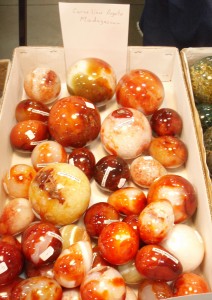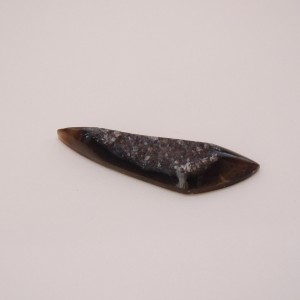- NEW DVD Series – Stone Setting with Bezels
- Tube Set Charm by Kim St. Jean
- Prong Basket Pendant by Kim St. Jean
- NEW DVD Series – Stone Setting with Cold Connections
- New DVD Series – Stone Setting with Wire
- NEW DVD Series: Introduction to Stone Setting by Kim St. Jean
- Featured Tool: Bracelet Bending Plier
- NEW Dvd by Eva Sherman
- Fun, Fast Fold Forming DVD Series
- Double Band Ear Cuff from Alex Simkin
Gem Profile April 20: Cryptocrystalline Quartz Introduction
by Rose Marion, Wire-Sculpture.com

Cryptocrystalline Quartz Introduction, one in a Series on Quartz
Shop Agate Cabochons | Shop Agate Beads
As you have become aware in recent months, there are many, many kinds of quartz dug from the earth’s surface! However, it wasn’t until the 1800s that the many kinds were recognized as all having the same substance, SiO2, making them all quartz. This was discovered by the Swedish chemists Bergmann and J. J. Berzelius.

Agate Spheres I photographed from Granite Mountain Nature Gallery's booth at a gem show here in Ogden.
The old system of categorizing quartzes broke quartz into 3 types: Macrocrystalline quartz, which develops as visible crystals (as we’ve discussed: examples are citrine, amethyst, and smoky quartz). Microcrystalline quartzes (agates) are made of tiny crystal grains that can be seen with a microscope. Cryptocrystalline quartz crystals (carnelian, chrysocolla) are so densely packed that they can’t even be seen with a microscope! We’ve used this system to discuss the quartzes in the gem profiles, and will continue to do so. However, in modern days, “quartz” typically refers to macrocrystalline quartz, while cryptocrystalline quartz is called chalcedony.
And yes – Jasper is often categorized under Chalcedony (kal-sedn-ee): Dale has discussed the jaspers in great detail in Gem Profiles starting here.
How are Macro- and Cryptocrystalline Quartz Different?
How is macrocrystalline quartz different from the crypto- and microcrystalline forms of quartz? First, let’s look at the outside appearance. Macrocrystalline quartz like amethyst and rose quartz are generally transparent-translucent, whereas cryptocrystallines like agates are more often opaque. Agates and cryptocrystallines can be slightly softer than macrocrystallines, 6.5 on Moh’s scale rather than a full 7. Cryptocrystallines have a duller, wax-like luster while microcrystallines have a shiny, vitreous luster. And Cryptocrystallines have a higher water content as well as other non-quartz ingredients, up to 20% more.
Because the cryptocrystalline quartzes can include several non-quartz minerals, many of these quartzes are considered “rocks,” rather than macrocrystalline amethyst, citrine, tigereye, and smoky quartz, which are more likely called “gems” or “stones” due to their purity.
Besides how they appear finished, the difference lies in how the quartz is formed. Generally speaking, in macrocrystalline quartzes like amethyst and phantom quartz, the quartz forms by adding molecules to the surface of the crystal, one layer at a time, jutting out into the surrounding environment. However, cryptocrystalline quartz emerges from a silica and water solution, usually formed precisely to its mold.
Types of Chalcedony (Cryptocrystalline)
Other types of chalcedony, besides agate, include, Carnelian, Chrysoprase, Onyx, Thundereggs, Petrified Wood, and some include Aventurine. Chalcedony is found all over the world, including in each of the 50 states. Chalcedony has been used since the Bronze Age, and was especially common along the Mediterranean: in jewelry, beads, and even wax seals – because hot wax would not stick to it. The name of chalcedony comes from the town Chalkedon, which is in present-day Istanbul, and was formerly an ancient Greek village. Idar-Oberstein, a German town, became renowned in the 19th century as a major chalcedony and agate processing center, preparing and dying the stones for carving and jewelry making. Many chalcedonies, especially agate, take dye very well, and some are heat-treated, such as carnelian, to deepen the coloration.
Agate is a variety of quartz (classified as chalcedony) that’s characterized by its fine banding and bright colors. Agates are typically about 90% quartz and 10% impurities and moganite, also SiO2 but in a different structure than quartz. Agates are associated with volcanic activity and can be found in metamorphic rocks. Agate’s been used in making jewelry and carvings for millennia, having been discovered along the Achates River in Sicily over 3,000 years ago.
Agate often fills cracks or veins in volcanic rock, or cavities in cooled lava – it can even be found in dinosaur bones. Many agates do not fill completely, in which case druzy quartz crystals can form. In fact, sometimes amethyst crystals will form! There are dozens of varieties of agates, including fire agate, tree and moss agate, plume agate, and the agate geodes I mentioned. I’ll be discussing some of these next week – send your agate pictures to tips@wire-sculpture.com, and they could be featured!
Resources
- https://www.quartzpage.de/gen_types.html
- https://en.wikipedia.org/wiki/Quartz#Microcrystalline_varieties
- https://en.wikipedia.org/wiki/Chalcedony
- https://www.rps.psu.edu/0109/form.html
- https://www.agatelady.com/agate-basics.html
- https://minerals.usgs.gov/minerals/pubs/commodity/gemstones/sp14-95/chalcedony.html
Gem Profile by Rose Marion
Click to Receive Daily Tips by Email























zoraida
April 20, 2012 at 7:44 am
I love all the informative, educational articles in your gem profiles! It’s wonderful to get this information without scouring the web. You guys literally rock!
Bob T
April 20, 2012 at 7:44 pm
I started out with lapidary when my dad caught the bug in the early 60’s. I was 7 or 8 at the time. My experience with “the rocks” served me well during my first career in archaeology and it was at that time working with an experimental archaeologist that I ran across the technique of heat treating flint or chalcedony or other forms of cryptocrystalline quartz used by native American flint knappers to modify the stone structure making it finer grained and more consistent for use in tool making. It also tended to bring out the reds in otherwise fairly dull stone types. The overall effect was to make cryptocrystlline much more like microcrystalline varieties. Interestingly, trying to treat finer grains quartz would simply crack and craze the stone, ruining the stone in the process.
Anyway, simply running across my old friend crypocrystalline quartz brought that all up